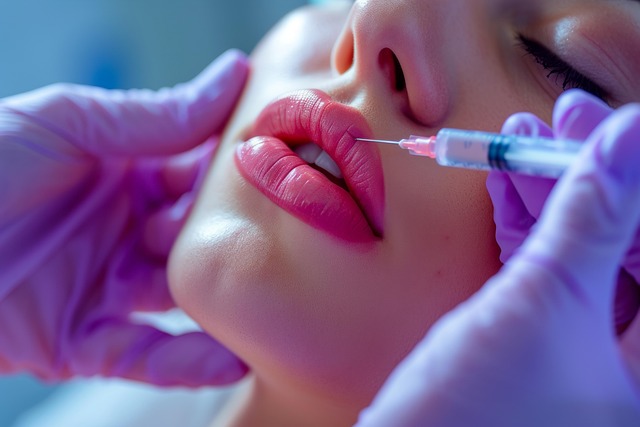This text compares Botox and dermal fillers as treatments for forehead wrinkles, highlighting their distinct mechanisms, benefits, risks, costs, and ideal candidates. Key takeaways:
– Both focus on reducing wrinkles but differ in approach: Botox relaxes muscles (dynamic wrinkles), while dermal fillers add volume (static wrinkles).
– Botox offers temporary (3-6 months) yet effective results from a non-invasive procedure with minimal downtime.
– Dermal fillers provide longer-lasting (6-18 months) results but are more expensive and require recurring treatments.
– The best choice depends on wrinkle type, severity, personal preference, budget, and desired treatment frequency.
“Uncover the secrets to a wrinkle-free forehead with Botox, a popular and effective treatment for cosmetic enhancement. This comprehensive guide explores the science behind Botox’s ability to smoothen expression lines and frown wrinkles. We delve into its comparison with dermal fillers, highlighting unique benefits tailored to forehead concerns. From understanding the causes of forehead wrinkles to navigating the step-by-step procedure and safety aspects, this article empowers you to make informed decisions between Botox vs dermal fillers for achieving a youthful complexion.”
Understanding Forehead Wrinkles and Their Causes

Forehead wrinkles, often referred to as frown lines or expression lines, are a common concern for many individuals as they age. These vertical creases between the eyebrows can be caused by various factors, primarily related to muscle activity and skin structure. Over time, repeated contractions of the brow muscles lead to dynamic wrinkles, while underlying fat loss and collagen degradation contribute to static wrinkles.
When considering treatments, Botox and dermal fillers are two popular options. Botox, a neurotoxin, works by temporarily paralyzing the muscles responsible for causing wrinkles. It’s particularly effective for dynamic lines. On the other hand, dermal fillers enhance the skin’s structure by injecting hyaluronic acid or other substances to plump and smoothen out static wrinkles. The choice between Botox and dermal fillers depends on the type and severity of wrinkles, as well as individual preferences.
The Role of Botox in Reducing Wrinkles

Botox has established itself as a leading treatment for reducing wrinkles, particularly on the forehead. Its mechanism of action involves relaxing specific muscles that are responsible for causing dynamic wrinkle formation. By injecting small amounts of Botox into targeted areas, practitioners can significantly reduce the appearance of frown lines, crow’s feet, and other expression lines. This non-surgical approach offers a temporary yet effective solution, making it a popular choice for individuals seeking a more youthful complexion without the need for extensive procedures.
In comparison to dermal fillers, which add volume and lift to the skin, Botox operates from a different angle. While dermal fillers can enhance specific areas of the face, Botox focuses on preventing muscle contractions that lead to wrinkles. This makes Botox an ideal treatment for people who want to maintain a natural look and avoid the more dramatic results often associated with fillers. As such, it provides a subtle yet effective way to combat age-related changes in the skin’s texture and appearance.
How Dermal Fillers Differ from Botox

Botox and dermal fillers are both popular cosmetic treatments, but they serve different purposes. Botox is a protein that relaxes muscles, making it ideal for smoothing expression lines on the forehead, glabella (between the eyebrows), and around the eyes. It’s a temporary solution, usually lasting 3-6 months, and works best for preventing or minimizing dynamic wrinkles caused by muscle movement.
On the other hand, dermal fillers are made of hyaluronic acid or collagen, which plumps up and adds volume to the skin. They’re used to correct static wrinkles, enhance facial contours, and add back lost volume due to aging or weight loss. Fillers can provide results that last anywhere from 6 months to several years, depending on the type used and individual factors. When considering Botox vs dermal fillers for a wrinkle-free forehead, it’s essential to consult with a qualified professional who can determine which treatment is best suited to your specific needs.
Benefits of Using Botox for Forehead Lines

Botox has emerged as a popular and effective solution for reducing forehead lines and wrinkles, offering several advantages over traditional dermal fillers. One of its key benefits is its ability to relax the muscles responsible for causing dynamic wrinkles, particularly in areas like the brow and forehead. Unlike dermal fillers that add volume, Botox works by preventing the contraction of these muscles, thus softening the appearance of fine lines and crow’s feet without adding any foreign substances to the skin.
Additionally, Botox treatments are minimally invasive, making it a less risky option compared to fillers. The procedure involves tiny injections into specific muscle sites, causing minimal discomfort and requiring no downtime. This quick and easy process allows individuals to achieve a youthful complexion with natural-looking results. Moreover, Botox has a longer-lasting effect, providing relief from wrinkles for several months, whereas dermal fillers may require more frequent top-ups.
The Procedure: Step-by-Step Guide to Botox Injection

The procedure for Botox injections for a wrinkle-free forehead involves several steps designed to minimize discomfort and maximize results. It begins with a consultation where a qualified professional assesses your skin, discusses expectations, and determines the appropriate dose of Botox. During the actual treatment, a fine needle is used to inject tiny amounts of Botox into specific forehead muscles responsible for frowning and wrinkling. This process targets dynamic wrinkles, those that form due to facial movements, as opposed to static wrinkles which are a result of aging alone.
Compared to dermal fillers, Botox offers a different approach. Fillers enhance the skin’s appearance by adding volume and smoothing out existing wrinkles, while Botox relaxes muscles to prevent future wrinkle formation. Both procedures have their merits, with Botox being ideal for preventing expression lines and maintaining a youthful forehead, while dermal fillers are excellent for restoring lost volume and defining facial contours. The choice between them depends on individual preferences and the specific concerns addressed.
Safety and Potential Side Effects of Botox Treatment

Botox has established itself as a popular choice for non-surgical facial rejuvenation, particularly for reducing forehead wrinkles. However, as with any medical procedure, it’s crucial to be aware of the safety profile and potential side effects. When compared to dermal fillers, another common cosmetic treatment, Botox offers a different approach. While fillers add volume by injecting substances like hyaluronic acid, Botox works by temporarily paralyzing muscles, smoothing out expression lines.
Although generally safe when administered by qualified healthcare professionals, Botox treatments may still cause temporary side effects such as mild bruising, swelling, or headaches. In rare cases, it can lead to more serious complications, including difficulty blinking or persistent muscle weakness. It’s essential to discuss these risks and benefits with a doctor before undergoing any cosmetic procedure, opting for the most suitable treatment – whether that’s Botox or dermal fillers – based on individual needs and concerns.
Recovery and Results: What to Expect After the Procedure

After your Botox or dermal filler treatment for forehead wrinkles, it’s normal to expect some temporary redness and swelling. These side effects are usually mild and subside within a few days. During this recovery period, it’s recommended to avoid strenuous activities and direct sun exposure to prevent irritation.
When it comes to results, Botox typically takes effect within 24 to 72 hours, offering a smoother appearance that can last for several months. Dermal fillers, on the other hand, provide instant results but may not last as long, usually between 6 to 18 months, depending on the specific filler used. Both procedures offer effective solutions for reducing forehead wrinkles, allowing you to achieve a youthful and refreshed look.
Cost Considerations: Botox vs Dermal Fillers

When considering treatments for wrinkle reduction, especially on the forehead, individuals often weigh the options between Botox and dermal fillers. Both procedures have their merits, but they differ significantly in terms of cost and results. Botox, a neurotoxin that relaxes muscles, offers a more temporary solution, typically lasting 3-6 months. This makes it a cost-effective choice for those seeking occasional, targeted treatments. On the other hand, dermal fillers provide longer-lasting results, often between 6 to 18 months, by adding volume and smoothing out wrinkles. While initially more expensive than Botox, dermal fillers represent a long-term investment as they reduce the need for frequent treatments.
The cost comparison between Botox and dermal fillers depends on various factors, including the treatment area, product used, and the provider’s fees. Botox generally ranges from $200 to $400 per session, depending on the quantity of units administered. Dermal fillers can vary widely in price, with options like hyaluronic acid fillers starting around $400 and more robust fillers costing upwards of $1000 per syringe. Long-term savings may be realized with dermal fillers, especially for extensive forehead wrinkling, as fewer treatments are required over time.
Choosing Between Botox and Dermal Fillers: Key Factors

When considering treatments for a wrinkle-free forehead, one of the key decisions is between Botox and dermal fillers. Both have their advantages and are popular choices in cosmetic procedures, but they work differently.
Botox is a neurotoxin that relaxes specific muscles, reducing the appearance of dynamic wrinkles, especially those caused by frowning or squinting. It’s a non-invasive procedure with immediate results, offering a temporary yet effective solution. On the other hand, dermal fillers enhance volume and lift by injecting a substance under the skin, plumping up deep wrinkles and adding definition to the forehead and brow area. Fillers provide longer-lasting results compared to Botox but require repeated treatments over time. The choice between the two depends on individual preferences, budget, and desired outcomes, with Botox vs dermal fillers each presenting unique benefits tailored to specific needs.
